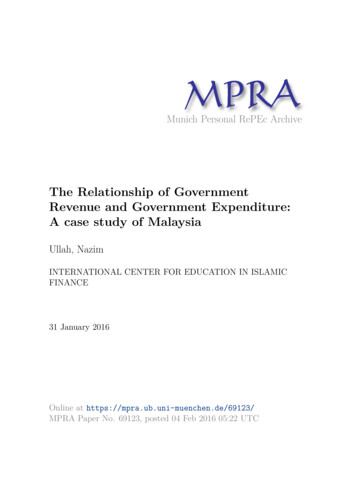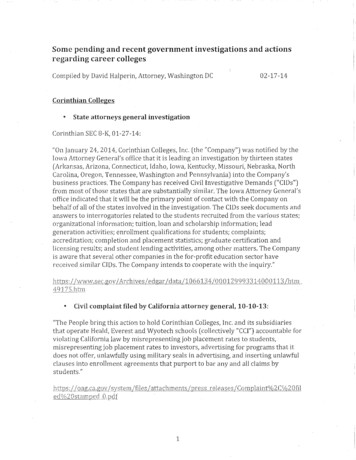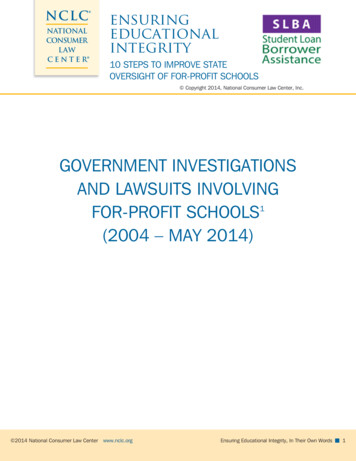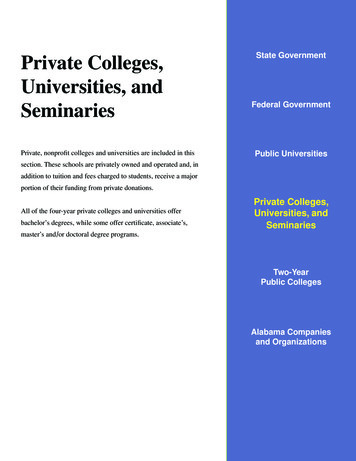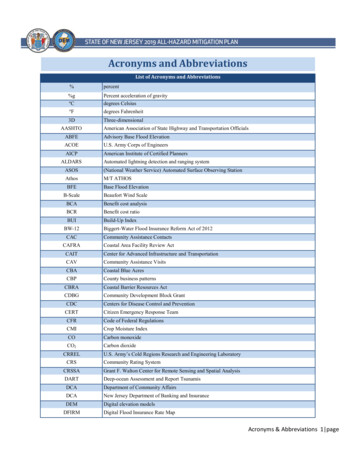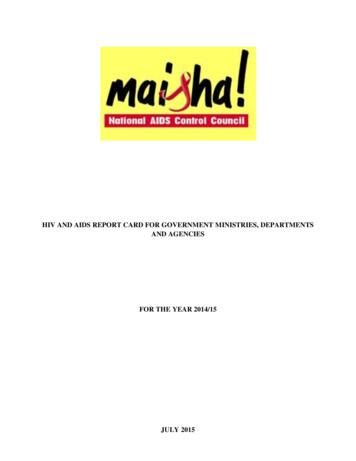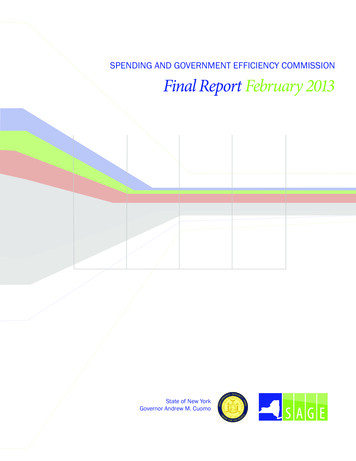
Transcription
SPENDING AND GOVERNMENT EFFICIENCY COMMISSIONFinal Report February 2013State of New YorkGovernor Andrew M. Cuomo
The Redesign of State GovernmentSAGE Commission Charter and MissionReorganizeState governmentFocus oncore missionandimplementationModernize and right-size governmentto make it more efficient, effectiveand accountableReduce costsand improveserviceBuild a cultureof performance andaccountabilityi
February 12, 2013ii
SAGE Commission TeamChairRobert Duffy, Lieutenant Governor of the State of New YorkVice-ChairPaul Francis, Director of Agency Redesign and EfficiencyCommission MembersMichael Balboni, RedLand Strategies Inc., President and Managing DirectorState Senator Greg Ball, NY District 40 (Designee of Senate Majority)Neil Cole, Iconix Brand Group, Inc., CEOJim Corcoran, James P. Corcoran, LLC, President and FounderState Assemblywoman Jane Corwin, NY District 142 (Designee of Assembly Minority)State Assemblyman Steve Englebright, NY District 4 (Designee of Assembly Majority)Cheryl Cohen Effron, Greater NY, FounderCheryl A. Felice, Suffolk County Association of Municipal Employees, Former PresidentAlan Gerry, Granite Associates, LP, Chairman and CEOBarry M. Gosin, Newmark, Grubb, Knight, Frank, CEODenis M. Hughes, New York State AFL-CIO, Former PresidentDerek G. Johnson, Integrated Holdings Corp., CEOState Senator Liz Krueger, NY District 26 (Designee of Senate Minority)Simone Levinson, Turnaround for Children, Vice Chairman of the Board of DirectorsLillian Rodríguez López, The Coca-Cola Company, Director of Latin AffairsAnthony E. Malkin, Malkin Holdings, LLC, PresidentKevin P. Ryan, Gilt Group, Founder and CEORobert Samson, IBM’s Global Public Sector, General Manager (Retired)Jonathan Sandelman, Mercer Park, LP, Managing PartnerRichard Sirota, Walter N. Danrich Organization, ChairmanPeter J. Solomon, Peter J. Solomon Company, LP, Founder and ChairmanAndrew J. Spano, Former Westchester County ExecutiveMax Stier, Partnership for Public Service, PresidentRobert Zimmerman, Zimmerman Edelson Inc., Partner and FounderStaffDerek Utter, Deputy Director of Agency Redesign and EfficiencyJames DeWan, Policy DirectorDani Cinali, Policy AnalystBrian Carlton Kilduff, Policy AnalystNick Willett-Jeffries, Policy AnalystBenjamin Wetzler, Policy AnalystLieutenant Governor’s StaffJohn Maggiore, Chief of StaffBrian Quiara, Director of Policyiii
HIGHLIGHTSPart I – Reorganizing Government The most comprehensive reorganization of State government since Governor Al Smith’s inthe 1920s:o Consolidations and Rightsizing of Facilities: Savings of approximately 294 million annually to berealized through closing excess prisons, adopting a community-based approach to juvenile justicewhich reduces the need for residential facilities, de-institutionalizing mental health and custodialcare facilities for persons with developmental disabilities, eliminating excess leased office spaceby “restacking” State agencies, and consolidating warehouses, printing and laboratory operations.o Consolidations of Functions: Savings of approximately 241 million annually to be realized throughconsolidation and modernization of back-office and support functions, including finance andHR operations, procurement, asset management and call centers. In addition to providing theseback-office and support functions through a shared services model, further efficiencies will beachieved through realignment of functions to better fit the host agency’s core mission, suchas the transfer of all Medicaid rate setting to the Department of Health and coordination of allemployee health insurance purchasing between the Department of Civil Service and the Department of Health, which will save approximately 104 million annually.o Consolidations of Agencies and Authorities: Mergers and consolidations involving a total of 14agencies and authorities have been completed or proposed in the 2013-14 Executive Budget.If the additional merger and consolidation options identified by the SAGE Commission for futureconsideration were also adopted, it will have reduced the number of major agencies and authorities by 23% since the Governor took office.o Coordination of Interagency Activities: Formal coordination mechanisms for critical interagencyactivities, including the NY Works Task Force for infrastructure and capital planning, RegionalEconomic Development Councils and a Consolidated Funding Application for economic development, a revitalized State Workforce Investment Board for all workforce development activities,and a statewide Master Plan for all energy efficiency initiatives in State facilities, will saveapproximately 100 million annually.Part II – Reducing Costs and Improving Service A comprehensive transformation of the State’s approach to information technology:oiv IT Organizational Restructuring: Savings of approximately 190 million annually from (i) organizationof the State’s 3,300 IT personnel and infrastructure operations into a new Information TechnologyServices organization, which is establishing statewide standards and managing personnel throughagency cluster CIOs who report directly to the State Chief Information Officer; and (ii) modernizationof IT infrastructure, including data centers, the conversion from traditional landlines to voice overInternet protocol (VoIP) telephone service, email standardization and user-identity management.
H I G H L I G H T S O F I N I T I AT I V E SHIGHLIGHTSo igh ROI/High Impact IT Projects: Savings of approximately 100 million annually from the acHceleration of the development of IT projects that have a high return on investment (ROI) or ahigh impact on customer service or other types of performance. Improved customer service and operational process efficiency:o ustomer Service Solutions: Greater convenience of licensing and permitting through an eClicensing platform that will allow online applications for more than 400 types of licensesissued by State agencies; significantly improve customer service at DMV by offering moreconvenient hours and reducing wait times by increasing the percentage of transactions thatcan be completed outside of a DMV office; and other initiatives.o perational Process Efficiencies: Streamlined management of the State’s contracting processOwith not-for-profit and other third-party providers improves their performance and createssavings for the State; Design-Build procurement authority for infrastructure projects producessavings of approximately 100 million annually. Modernizing the workforce:o ontrolling the Cost of the State Workforce: Savings of approximately 421 million from costCcontrols through new collective bargaining agreements with no salary increases in the outsetof the contracts, increased employee contributions for health insurance, and a new Tier VIpension plan that will save the State and local governments more than 80 billion over thenext 30 years.o Workforce Flexibility: Increased flexibility in hiring and managing employees.Part III – Building a Culture of Performance and Accountability First-ever statewide performance initiatives:oEducation: Performance-based school aid and teacher evaluation system.o ew York Performs: A statewide performance management system for all major agencies andNauthorities, to be launched publicly by the end of 2013.o pen New York: Initiatives to increase State government transparency and expand access toOState government services, records and data. Focus on core mission and effective implementation:o Core Mission: Framework for review of activities that are not central to advancing the core missionof State government.oI mplementation: Support implementation of government redesign initiatives through the use ofLEAN management process and by leveraging private sector resources and expertise.v
H I G H L I G H T S O F I N I T I AT I V E SS AV I N G S U P O N F U L L I M P L E M E N TAT I O NAnnual Savings (MM)Consolidation and Rightsizing of FacilitiesClosing Excess Prisons 174Community-based Juvenile Justice Strategy44Deinstitutionalization of Mental Health and Developmental Disabilities Care50Office Space Re-stacking26Consolidation of Functions and Enterprise Shared ServicesBusiness Services CenterProcurement and Strategic SourcingCluster-based Call CentersCoordinated Health Insurance Purchasing6316018104Consolidation of Agencies and AuthoritiesMergers and Consolidations75Information TechnologyOrganizational Restructuring90IT Infrastructure Modernization100High ROI IT Projects100Process ImprovementsDesign-Build Procurement100*Energy Efficiency Master Plan100Modernizing the WorkforceTier VI Pension PlanIncreased Employee Contribution to Health InsuranceControlling Wage IncreasesTotal**260161 1,625* Represents 10% savings on the estimated amount of annual infrastructure spending affected by the Design-Buildauthority under the Infrastructure Investment Act. Excludes savings from the Tappan Zee Bridge project which are estimated to be at least 1 billion.** The Tier VI pension plan will save the State approximately 21 billion and localities approximately 61 billion overthe next 30 years.vi
CONTENTSCHAPTER 1: INTRODUCTION. 1Background on the SAGE Commission. 1Preparing For the Work of the Commission. 1The Commission’s Charter and Scope. 2New York State’s Fiscal Situation. 3The New York State Workforce. 4The Organizational Structure of New York State. 5Transforming State Government Performance. 5Summary of Initiatives . 7PART I: Reorganizing Government. 14CHAPTER 2: CONSOLIDATION AND RIGHTSIZING OF FACILITIES. 14Rightsizing Prisons and Custodial Care Facilities . 14Closing Excess Prisons. 14Community-Based Juvenile Justice Strategy. 14De-institutionalization of Mental Health and Developmental Disabilities Care. 15Consolidating Real Estate and Ancillary Activities. 16Office Space Re-stacking. 16Warehouses. 17Printing Operations. 17Laboratory Facilities. 18Fleet Management. 18CHAPTER 3: CONSOLIDATION OF FUNCTIONS. 19Enterprise Shared Services. 19Business Services Center. 20Procurement and Strategic Sourcing. 20Cluster-Based Call Centers. 21Shared Services with Other State Entities and Local Governments. 22Realignment of Functions. 22Creation of the Justice Center. 22Belleayre Ski Center to ORDA. 23Health and Disabilities Cluster Shared Services. 23Coordinated Health Insurance Purchasing. 24Homeless Housing Assistance Program to HCR. 25Mitchell-Lama Housing Portfolio to HCR. 26Realignment of Overlapping Functions between DPS and NYSERDA. 27Coastal Zone Management to DEC. 28CHAPTER 4: CONSOLIDATION OF AGENCIES AND AUTHORITIES. 29Completed Mergers and Consolidations. 30Department of Financial Services. 30Department of Corrections and Community Supervision. 31Merger of NYSTAR into Empire State Development. 31Merger of the Consumer Protection Board into the Department of State. 31Gaming Commission. 312013-14 Executive Budget Proposals. 32Merger of the Welfare Inspector General (OWIG) into the Office of the Inspector General. 32Consolidation of the Governor’s Office of Employee Relations and the Department of Civil Service. 33Future Options. 33Privatization of the Long Island Power Authority. 33vii
Consolidation of Transportation Agencies and Authorities. 34Merger of Behavioral Health Agencies. 37Higher Education Services Corporation Consolidation. 39Merger of the Hudson River Valley Greenway into the Department of Environmental Conservation. 40Administrative Public Safety Agencies Consolidation. 41Business and Professional Licensing Agency. 42Elimination of Unnecessary Boards and Commissions. 43Potential Mergers Reviewed but Not Recommended. 44Areas for Further Review. 44Dormitory Authority. 45NYC Urban Planning and Development. 45Buffalo and Ft. Erie Public Bridge Authority and the Niagara Falls Bridge Commission. 45CHAPTER 5: COORDINATION OF INTER-AGENCY ACTIVITIES. 47New Formal Coordination Mechanisms. 47Regional Economic Development Councils. 47Consolidated Funding Application. 48NY Works Task Force Capital Planning. 48Workforce Development Initiatives. 50Revitalize the State Workforce Investment Board (SWIB). 50Linking Community College Aid to Employer Partnerships. 51Consistent Performance Metrics for Workforce Development Programs. 52Energy . 53Master Plan for Energy Efficiency in All State Facilities. 53Reorganizing Emergency Response. 56PART II: Reducing Costs And Improving Service. 57CHAPTER 6: INFORMATION TECHNOLOGY TRANSFORMATION. 57Enterprise-wide Initiatives. 57Organizational Restructuring. 58IT Infrastructure Modernization. 60IT-Enabled Business Process Redesign. 62Accelerating High ROI / High Impact IT Projects. 62Rent Regulation System Redesign. 64Workers’ Compensation Claims System Redesign. 65CHAPTER 7: CUSTOMER SERVICE AND PROCESS IMPROVEMENT. 67Customer Service Solutions Involving Licensing and P
agencies and authorities have been completed or proposed in the 2013-14 Executive Budget. If the additional merger and consolidation options identified by the SAGE Commission for future consideration were also adopted, it will have reduced the number of major agencies and authori - ties by 23% since the Governor took office.
